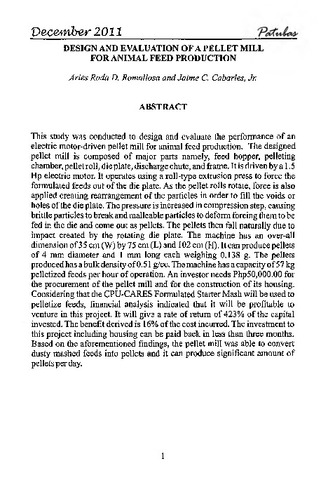Design and evaluation of a pellet mill for animal feed production
| dc.contributor.author | Romallosa, Aries Roda D. | |
| dc.contributor.author | Cabarles, Jaime C. Jr. | |
| dc.date.accessioned | 2021-03-22T02:23:08Z | |
| dc.date.available | 2021-03-22T02:23:08Z | |
| dc.date.issued | 2011-12 | |
| dc.identifier.citation | Romallosa, A. R. D. & Cabarles, J. C. (2011). Design and evaluation of a pellet mill for animal feed production. Patubas, 6(1), 1-17. | en_US |
| dc.identifier.issn | 1908-515X | |
| dc.identifier.uri | https://hdl.handle.net/20.500.12852/627 | |
| dc.description | Journal article | en_US |
| dc.description.abstract | This study was conducted to design and evaluate the performance of an electric motor-driven pellet mill for animal feed production. The designed pellet mill is composed of major parts namely, feed hopper, pelleting chamber, pellet roll, die plate, discharge chute, and frame. It is driven by a 1.5 Hp electric motor. It operates using a roll-type extrusion press to force the formulated feeds out of the die plate. As the pellet rolls rotate, force is also applied creating rearrangement of the particles in order to fill the voids or holes of the die plate. The pressure is increased in compression step, causing brittle particles to break and malleable particles to deform forcing them to be fed in the die and come out as pellets. The pellets then fall naturally due to impact created by the rotating die plate. The machine has an over-all dimension of 35 cm (W) by 75 cm (L) and 102 cm (H). It can produce pellets of 4 mm diameter and 1 mm long each weighing 0.138 g. The pellets produced has a bulk density of 0.51 g/cc. The machine has a capacity of 57 kg pelletized feeds per hour of operation. An investor needs Php50,000.00 fo r the procurement of the pellet mill and for the construction of its housing. Considering that the CPU-CARES Formulated Starter Mash will be used to pelletize feeds, financial analysis indicated that it will be profitable to venture in this project. It will give a rate of return of 423% of the capital invested. The benefit derived is 16% of the cost incurred. The investment to this project including housing can be paid back in less than three months. Based on the aforementioned findings, the pellet mill was able to convert dusty mashed feeds into pellets and it can produce significant amount of pellets per day. | en_US |
| dc.language.iso | en | en_US |
| dc.publisher | Central Philippine University | en_US |
| dc.subject.lcsh | Feeds | en_US |
| dc.subject.lcsh | Feed processing | en_US |
| dc.subject.lcsh | Pelleted feed | en_US |
| dc.subject.lcsh | Feed mills | en_US |
| dc.subject.lcsh | Feed mills--Equipment and supplies | en_US |
| dc.subject.lcsh | Feed mills--Design and construction | en_US |
| dc.subject.lcsh | Pelletizing | en_US |
| dc.title | Design and evaluation of a pellet mill for animal feed production | en_US |
| dc.type | Article | en_US |
| dc.citation.firstpage | 1 | en_US |
| dc.citation.lastpage | 17 | en_US |
| dc.citation.journaltitle | Patubas | en_US |
| dc.citation.volume | 6 | en_US |
| dc.citation.issue | 1 | en_US |
Fichier(s) constituant ce document
Ce document figure dans la(les) collection(s) suivante(s)
-
Journal articles [25]
-
Patubas [110]
Patubas is a refereed research journal of Central Philippine University.


